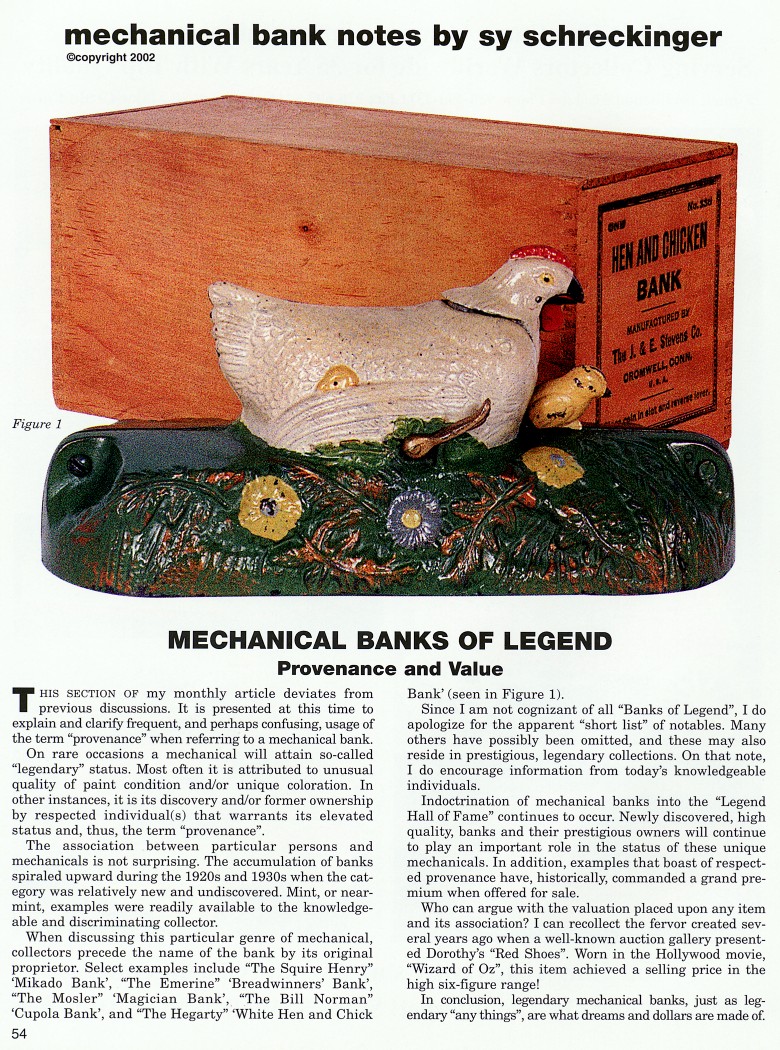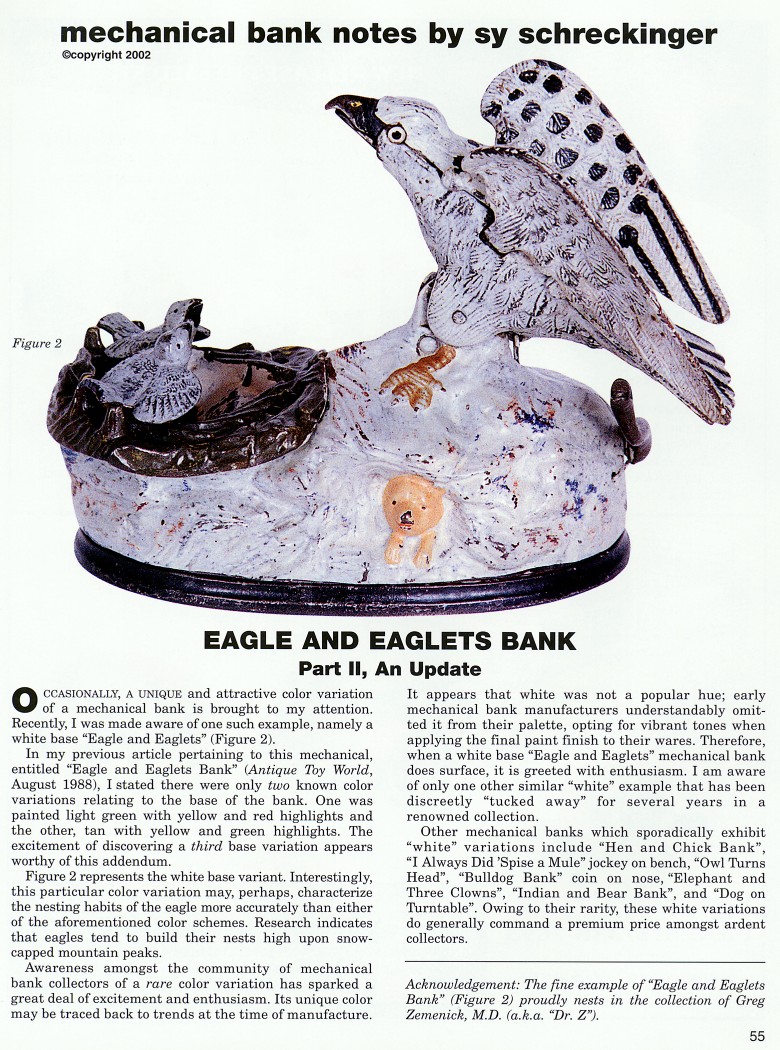|
Mechanical Banks of Legend
Provenance and Value
by Sy Schreckinger – ANTIQUE TOY WORLD Magazine – May, 2002
This section of my monthly article deviates from
previous discussions. It is presented at this time to explain and clarify
frequent, and perhaps confusing, usage of the term "provenance" when
referring to a mechanical bank.
On rare occasions a mechanical will attain so-called "legendary"
status. Most often it is attributed to unusual quality of paint condition
and/or unique coloration. In other instances, it is its discovery and/or
former ownership by respected individual(s) that warrants its elevated
status and, thus, the term "provenance".
The association between particular persons and mechanicals is not
surprising. The accumulation of banks spiraled upward during the 1920s and
1930s when the category was relatively new and undiscovered. Mint, or
near-mint, examples were readily available to the knowledgeable and
discriminating collector.
When discussing this particular genre of mechanical, collectors
precede the name of the bank by its original proprietor. Select examples
include "The Squire Henry" 'Mikado Bank', "The Emerine"
'Breadwinners'
Bank', "The Mosler" 'Magician Bank', "The Bill Norman"
'Cupola Bank', and
"The Hegarty" 'White Hen and Chick Bank' (seen in Figure 1).
Since I am not cognizant of all "Banks of Legend", I do apologize for
the apparent "short list" of notables. Many others have possibly been
omitted, and these may also reside in prestigious, legendary collections.
On that note, I do encourage information from today's knowledgeable
individuals.
Indoctrination of mechanical banks into the "Legend Hall of Fame"
continues to occur. Newly discovered, high quality, banks and their
prestigious owners will continue to play an important role in the status
of these unique mechanicals. In addition, examples that boast of respected
provenance have, historically, commanded a grand premium when offered for
sale.
Who can argue with the valuation placed upon any item and its
association? I can recollect the fervor created several years ago when a
well-known auction gallery presented Dorothy's "Red Shoes". Worn in the
Hollywood movie, "Wizard of Oz", this item achieved a selling price in the
high six-figure range!
In conclusion, legendary mechanical banks, just as legendary "any
things", are what dreams and dollars are made of.
Eagle and Eaglets Bank
Part II, an update
by Sy Schreckinger – ANTIQUE TOY WORLD Magazine – May, 2002
Occasionally a unique and attractive color
variation of a mechanical bank is brought to my attention. Recently, I was
made aware of one such example, namely a white base "Eagle and Eaglets"
(Figure 2).
In my previous article pertaining to this mechanical, entitled "Eagle
and Eaglets Bank" (Antique Toy World,
August 1988), I stated there were
only two known color variations relating to the base of the bank. One was
painted light green with yellow and red highlights and the other, tan with
yellow and green highlights. The excitement of discovering a third base
variation appears worthy of this addendum.
Figure 2 represents the white base variant. Interestingly, this
particular color variation may, perhaps, characterize the nesting habits
of the eagle more accurately than either of the aforementioned color
schemes. Research indicates that eagles tend to build their nests high
upon snowcapped mountain peaks.
Awareness amongst the community of mechanical bank collectors of a
rare color variation has sparked a great deal of excitement and
enthusiasm. Its unique color may be traced back to trends at the time of
manufacture. It appears that white was not a popular hue; early mechanical
bank manufacturers understandably omitted it from their palette, opting
for vibrant tones when applying the final paint finish to their wares.
Therefore, when a white base "Eagle and Eaglets" mechanical bank does
surface, it is greeted with enthusiasm. I am aware of only one other
similar "white" example that has been discreetly "tucked away" for several
years in a renowned collection.
Other mechanical banks which sporadically exhibit "white" variations
include "Hen and Chick Bank", "I Always Did 'Spise a Mule" jockey on
bench, "Owl Turns Head", "Bulldog Bank" coin on nose, "Elephant and Three
Clowns", "Indian and Bear Bank", and "Dog on Turntable". Owing to their
rarity, these white variations do generally command a premium price
amongst ardent collectors.
Acknowledgement: The fine example of "Eagle and Eaglets Bank" (Figure
2) proudly nests in the collection of Greg Zemenick, M.D. (a.k.a. "Dr.
Z").
|


